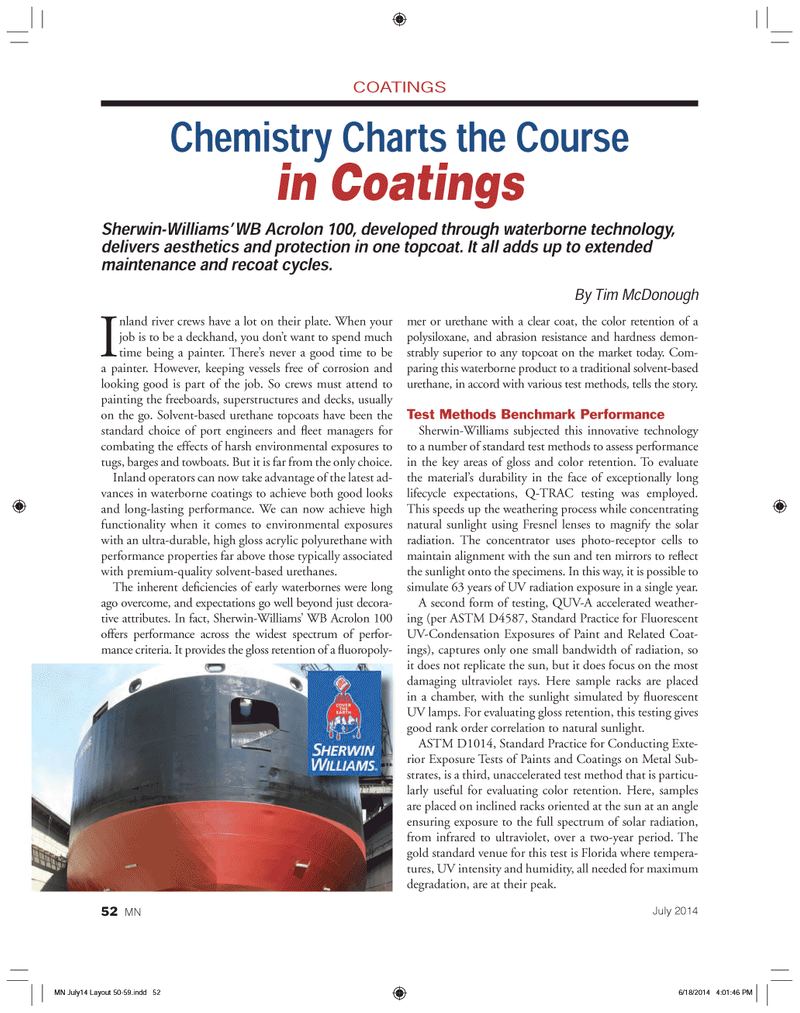
Page 52: of Marine News Magazine (July 2014)
ATB Technical Trends
Read this page in Pdf, Flash or Html5 edition of July 2014 Marine News Magazine
Chemistry Charts the Course in CoatingsSherwin-Williams? WB Acrolon 100, developed through waterborne technology, delivers aesthetics and protection in one topcoat. It all adds up to extended maintenance and recoat cycles. By Tim McDonough Inland river crews have a lot on their plate. When your job is to be a deckhand, you don?t want to spend much time being a painter. There?s never a good time to be a painter. However, keeping vessels free of corrosion and looking good is part of the job. So crews must attend to painting the freeboards, superstructures and decks, usually on the go. Solvent-based urethane topcoats have been the standard choice of port engineers and eet managers for combating the effects of harsh environmental exposures to tugs, barges and towboats. But it is far from the only choice. Inland operators can now take advantage of the latest ad- vances in waterborne coatings to achieve both good looks and long-lasting performance. We can now achieve high functionality when it comes to environmental exposures with an ultra-durable, high gloss acrylic polyurethane with performance properties far above those typically associated with premium-quality solvent-based urethanes. The inherent de ciencies of early waterbornes were long ago overcome, and expectations go well beyond just decora- tive attributes. In fact, Sherwin-Williams? WB Acrolon 100 offers performance across the widest spectrum of perfor- mance criteria. It provides the gloss retention of a uoropoly- mer or urethane with a clear coat, the color retention of a polysiloxane, and abrasion resistance and hardness demon- strably superior to any topcoat on the market today. Com- paring this waterborne product to a traditional solvent-based urethane, in accord with various test methods, tells the story. Test Methods Benchmark Performance Sherwin-Williams subjected this innovative technology to a number of standard test methods to assess performance in the key areas of gloss and color retention. To evaluate the material?s durability in the face of exceptionally long lifecycle expectations, Q-TRAC testing was employed. This speeds up the weathering process while concentrating natural sunlight using Fresnel lenses to magnify the solar radiation. The concentrator uses photo-receptor cells to maintain alignment with the sun and ten mirrors to re ect the sunlight onto the specimens. In this way, it is possible to simulate 63 years of UV radiation exposure in a single year. A second form of testing, QUV-A accelerated weather- ing (per ASTM D4587, Standard Practice for Fluorescent UV-Condensation Exposures of Paint and Related Coat- ings), captures only one small bandwidth of radiation, so it does not replicate the sun, but it does focus on the most damaging ultraviolet rays. Here sample racks are placed in a chamber, with the sunlight simulated by uorescent UV lamps. For evaluating gloss retention, this testing gives good rank order correlation to natural sunlight. ASTM D1014, Standard Practice for Conducting Exte- rior Exposure Tests of Paints and Coatings on Metal Sub- strates, is a third, unaccelerated test method that is particu- larly useful for evaluating color retention. Here, samples are placed on inclined racks oriented at the sun at an angle ensuring exposure to the full spectrum of solar radiation, from infrared to ultraviolet, over a two-year period. The gold standard venue for this test is Florida where tempera- tures, UV intensity and humidity, all needed for maximum degradation, are at their peak. COATINGS July 201452 MNMN July14 Layout 50-59.indd 52MN July14 Layout 50-59.indd 526/18/2014 4:01:46 PM6/18/2014 4:01:46 PM

 51
51

 53
53
